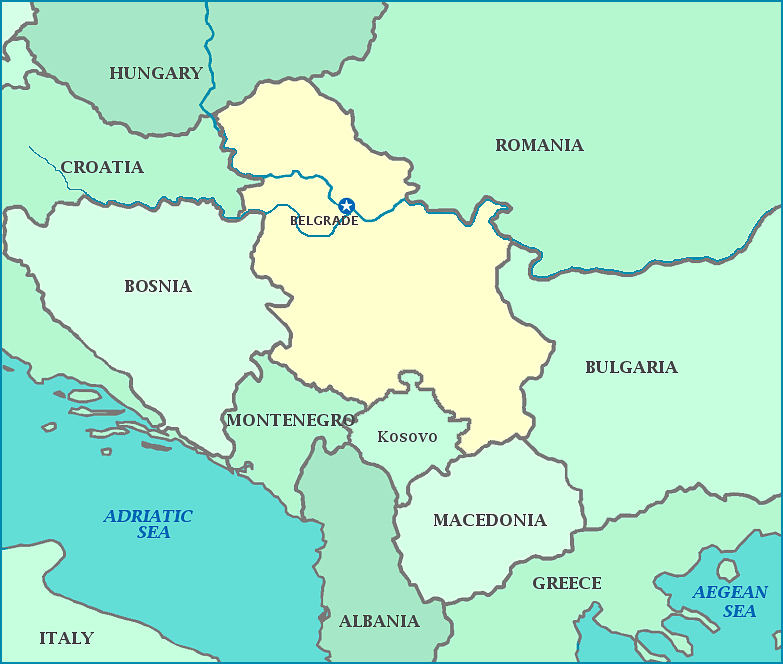August
2, 2015
34C today.
Image
credit
http://www.yourchildlearns.com/online-atlas/images/serbia_map.gif
Our
boat went a couple of hundred km overnight, and we woke up in
Belgrade (Beograd), the capital city of Serbia. Belgrade means
“White City”, named after the white wall of the fortress that
defends the city. The city has been destroyed about 20 times and
rebuilt every time. It has a population of 1.6 million.
Anton's favourite Serbian proverb: Be humble for you are made of earth. Be noble for you are made of stars.
Anton's favourite Serbian proverb: Be humble for you are made of earth. Be noble for you are made of stars.
Frankie's favourite Serbian proverb: A good reputation is better than a golden girdle.
The only Serbian word commonly known across the world is "vampire".
Frankie was sick overnight, so she thought she would stay in bed for the morning. But the boom boom boom of the houseboats drove her crazy, so she got up and did okay for the day. We were back to our bus excursions again. Today we had to carry our passports with us. Hopefully room 209 and 211 remember to give their passes and passports back when they come back on board. We have been warned that immigration may board the boat and do a face check of all the passengers, at 2 am.
In the morning we started with a tour of Belgrade Fortress. Belgrade Fortress is located on top of a 125.5 meter high ridge at the junction of the Danube and Sava rivers. The fortress dates to the 3rd century BC when the city of Belgrade was founded. At that time the entire population of the city lived within the protective walls of the fortress. Throughout the centuries, the fortress has belonged to the Roman, Byzantine, Ottoman, Serbian, and Austrian empires, and has changed hands 66 times. The fortress has been fought over 115 times and destroyed 44 times.
In the morning we started with a tour of Belgrade Fortress. Belgrade Fortress is located on top of a 125.5 meter high ridge at the junction of the Danube and Sava rivers. The fortress dates to the 3rd century BC when the city of Belgrade was founded. At that time the entire population of the city lived within the protective walls of the fortress. Throughout the centuries, the fortress has belonged to the Roman, Byzantine, Ottoman, Serbian, and Austrian empires, and has changed hands 66 times. The fortress has been fought over 115 times and destroyed 44 times.
Surrounding
Belgrade Fortress is a large park named Kalemegdan. The name comes
from the Turkish words kale (fortress) and meydan (battlefield). This is where the Danube and Sava rivers meet.
After
the Fortress and the park, we had a driving tour of
Belgrade. We stopped in the Square of the Republic in the center of
the city. When the Turks ruled, they used to use one of the gates to
hang convicts. When the Turks left, Prince
Mihailo ordered the gate to be demolished. In
the late 1800s, a statue of Prince Mihailo was erected.
Of
course we were given time to explore the nearby pedestrian
shopping area. We had been "lucky" enough to get 730 dinars from the currency exchange in Guelph. That is all of $9, so we were NOT bringing any of that home! We bought a cheesy souvenir and gave the rest to an old lady who was begging. The Serbian currency has fluctuated so much that they actually had at one time a $500 billion dollar bill. We almost bought one for 3 euros.
Sveti Sava is the largest Orthodox church in the Balkans, (they want it to be the largest Orthodox church in the world) and is one of the top 10 largest churches in the world. The dome is 230 feet high, with 4 steeples 144 feet tall each. It can hold 10,000 worshippers and a choir of 800. The church is built on the site where the Turks burnt the remains of St Sava in 1595. The church is still being worked on, financed solely by donations. It has already been over 100 years and it is still a concrete shell.
We
had lunch on board the ship, then we were given the choice to explore
Belgrade on our own or take the optional tour to an art colony. Lucky for us, we could choose a bike tour. Marilyn and JD, and Dale joined us. We went to part of the city that we had not seen in the morning, and there were some nice bike paths along the Danube.
In 1999, NATO "accidentally" bombed the Chinese embassy. Using 5 guided bombs.
We returned from our bike tour at 5 pm, and there was a presentation in the lounge about Serbia at 5:45. Dinner (which is always at 7 pm) was a "Taste of the Balkans" affair.
The Serbians know how to do graffiti:
The Serbians know how to do graffiti:











Fantastic! Hope you're feeling better Frankie!
ReplyDeleteWhat did they serve as Serbian food?
ReplyDeleteWhat did they serve as Serbian food?
ReplyDeleteThis comment has been removed by a blog administrator.
ReplyDelete